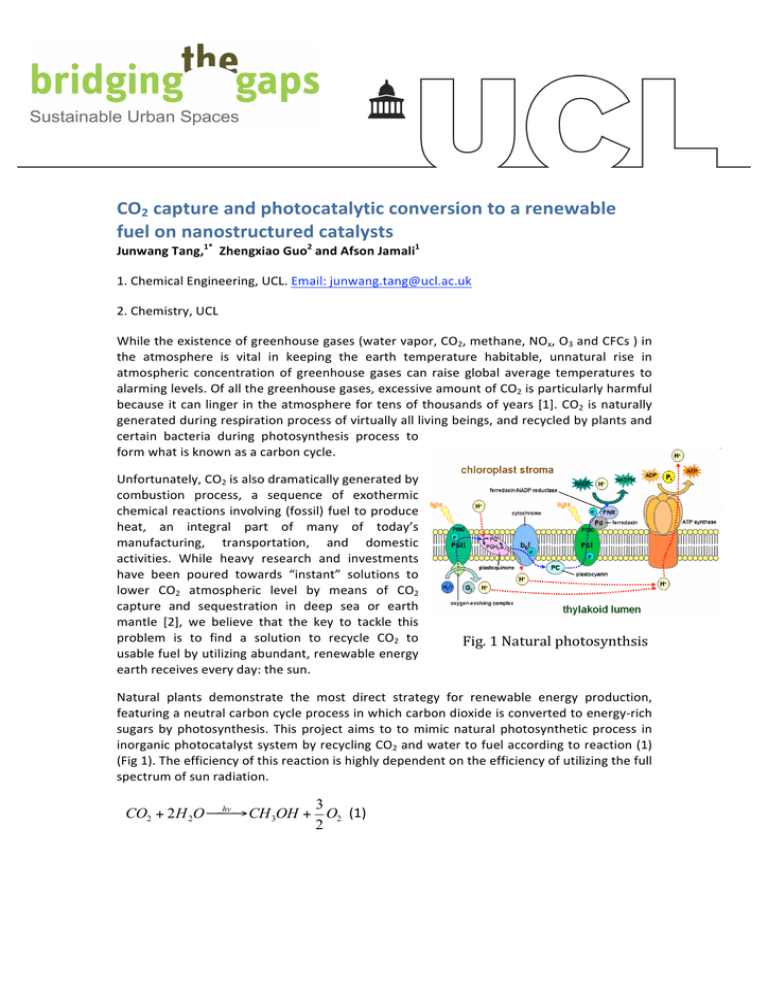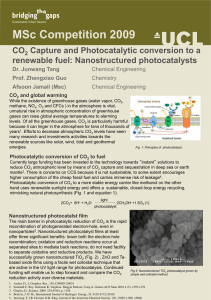CO capture and photocatalytic conversion to a renewable fuel on nanostructured catalysts
advertisement

CO2 capture and photocatalytic conversion to a renewable fuel on nanostructured catalysts Junwang Tang,1* Zhengxiao Guo2 and Afson Jamali1 1. Chemical Engineering, UCL. Email: junwang.tang@ucl.ac.uk 2. Chemistry, UCL While the existence of greenhouse gases (water vapor, CO2, methane, NOx, O3 and CFCs ) in the atmosphere is vital in keeping the earth temperature habitable, unnatural rise in atmospheric concentration of greenhouse gases can raise global average temperatures to alarming levels. Of all the greenhouse gases, excessive amount of CO2 is particularly harmful because it can linger in the atmosphere for tens of thousands of years [1]. CO2 is naturally generated during respiration process of virtually all living beings, and recycled by plants and certain bacteria during photosynthesis process to form what is known as a carbon cycle. Unfortunately, CO2 is also dramatically generated by combustion process, a sequence of exothermic chemical reactions involving (fossil) fuel to produce heat, an integral part of many of today’s manufacturing, transportation, and domestic activities. While heavy research and investments have been poured towards “instant” solutions to lower CO2 atmospheric level by means of CO2 capture and sequestration in deep sea or earth mantle [2], we believe that the key to tackle this problem is to find a solution to recycle CO2 to usable fuel by utilizing abundant, renewable energy earth receives every day: the sun. Fig. 1 Natural photosynthsis Natural plants demonstrate the most direct strategy for renewable energy production, featuring a neutral carbon cycle process in which carbon dioxide is converted to energy‐rich sugars by photosynthesis. This project aims to to mimic natural photosynthetic process in inorganic photocatalyst system by recycling CO2 and water to fuel according to reaction (1) (Fig 1). The efficiency of this reaction is highly dependent on the efficiency of utilizing the full spectrum of sun radiation. 3 hv CO2 + 2 H 2O → CH 3OH + O2 (1) 2 To realize a practical and efficient inorganic photosynthetic system, the first step is to synthesize and deposit active photocatalysts in film form. We used a simple, solution based coating method to get a robust, nanostructured film on glass substrates that are sensitive to light irradiation, eg. nanostructured TiO2, ZnO etc (Fig 2). The prepared films have a porous structure, which allow reactants, such as water and CO2 to contact as large surface area of the photocatalyst as possible. The method is proven to be consistent and repeatable, therefore can be applied to wider array of more complex photocatalysts that we are currently developing. The next step is to demonstrate the feasibility of using these inorganic films to convert CO2 and water to fuel, such as methanol and oxygen by a light‐driven photocatalytic reduction process, which can be realized with continued support from the University. Fig. 2 Nanostructured TiO2 film prepared a facile and reproducible approach. photosynthsis If successful, this project has the potential to develop to a larger project for renewable synthesis of carbon based liquid fuels. 1. 2. Archer, D., Fate of fossil fuel CO2 in geologic time. Journal of Geophysical Research, 2005. 110: p. C09S05. Charles, D., Stimulus Gives DOE Billions for Carbon‐Capture Projects. Science, 2009. 323(5918): p. 1158.









